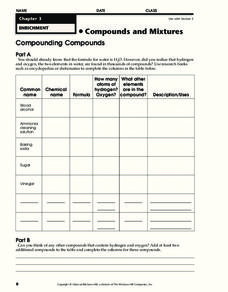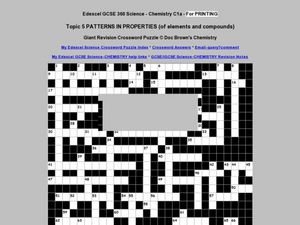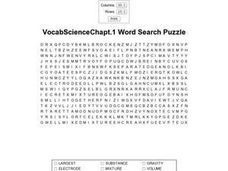Curated OER
Volumetric Analysis / Titration
Titration, and the lab skills that are needed to support it, is detailed here, with the reasoning behind standard solutions, concentration and volumetric analysis covered. Your young lab assistants will learn the skills of determining...
Virginia Department of Education
Laboratory Safety and Skills
Avoiding lab safety rules will not give you super powers. The lesson opens with a demonstration of not following safety rules. Then, young chemists practice their lab safety while finding the mass of each item in a mixture and trying to...
Curated OER
Solubility
In this solubility worksheet, students determine which solute will be more soluble in the solvent listed. Students complete 7 matching and 3 problems to solve.
Curated OER
Straw Chromatography
High schoolers separate food coloring using liquid chromatography. For this chemistry lesson, students explain the effects of different solvents on the rate of separation.
Curated OER
Study the Fizz
Students hypothesize about the amount of carbon dioxide in soda bottles. In this chemistry lesson plan, students design an experiment to solve the problem. They share findings in class.
Curated OER
Rate of Solution Demonstration
Young scholars explore the factors that can increase the rate of dissolution for a solid. They complete a laboratory exploration in which they compare the dissolution rate of a whole sugar cube to that of a crushed sugar cube in a...
Curated OER
Moles
In this moles worksheet, students review solubility, moles of solute, molar mass, and colligative properties. This worksheet has 10multiple choice questions and 11 problems to solve.
Curated OER
Substitution and Elimination Reactions
In this chemistry worksheet, students complete the reactions by drawing structures of major products, indicating important minor products. They also write the structure of the product and describe the stereo chemistry of the product.
Curated OER
Water Resource Engineering
Learners examine solubility and the significance of water. In this aqueous solution instructional activity students complete a lab activity on soil profiles.
Curated OER
Ions in the Environment
Students explain the importance of the five main biogeochemical cycles. In this chemistry lesson plan, students discuss how ions are transported in the environment. They design an experiment to collect data on eutrophication.
American Chemical Society
Does Temperature Affect Dissolving?
When making sweet tea, why do people dissolve the sugar in hot tea instead of cold tea? The class discusses the previous lab and builds upon it. Working in groups, they design an experiment to determine how temperature affects the...
Teach Engineering
Chromatography Lab
Groups use alcohol and chromatography paper to separate the color components of black ink. The purpose of the activity is to allow the class to become aware that mixtures exist in hidden places.
Curated OER
Science: Quick Freeze
Learners observe an experiment of freezing point depression using club soda. Through observation, they note that the carbon dioxide molecules disrupt the capacity of the water molecules to solidify. Precautions must be taken to assure...
Curated OER
Compounds
In this chemistry worksheet, learners complete a chart about common compounds. Examples include baking soda, sugar, and wood alcohol.
Curated OER
The Nature Of Dissolving Processes
Young scholars examine the rule of "like dissolves like." They define and describe solutions and solubility models on molecular liquids, ionic solids, and molecular solids.
Curated OER
Patterns in Properties (of elements and compounds)
For this element properties worksheet, learners complete a crossword puzzle with 91 questions related to properties of elements and compounds.
Curated OER
Vocab Science Chapter 1
In this word search worksheet, students locate 20 words related to science. The word list includes volume, mixture, and solute.
Curated OER
The Connection Between Pigment and Light Colors
Young scholars explain the mole concept and use this concept to prepare chemical solutions of particular molarities.
Curated OER
To Smell or Not to Smell, That is the Ester
Students explain the basic concepts of polymerization. Students participate in a lab to create a crude preparation of carboxyl esterase and test its effectiveness in reducing the residual monomer in an emulsion such as paint.
Science Geek
Thermochemical Calculations
Viewers learn where the heat goes when phase changes take place with a presentation that explains the latent heat of phase changes, or, more specifically, the molar heat of fusion, solidification, vaporization, and condensation. The show...
Curated OER
Microscopes and Crystals
Students observe crystals under the microscope. In this science lesson, students compare how the crystal look like using their eyes, hand lens and microscope. They identify the type of crystal based on the amount of light they allow to...
Curated OER
Stoichiometry
In this stoichiometry activity, students review definitions and equations associated with molarity, density, atomic mass, molarity, and dilutions. This activity has 18 word problems.
Curated OER
Using Chromatography to Identify Unknowns
Learners are introduced to the concept of chromatography. They practice using new vocabular and observing experiments. They answer discussion questions to end the lesson plan.
Curated OER
Properties of Matter (Biomaterial Through Nanotechnology)
Students investigate friction between different surfaces. In this physics lesson, students research biomaterials that can reduce friction. They calculate efficiency using a mathematical formula.

























